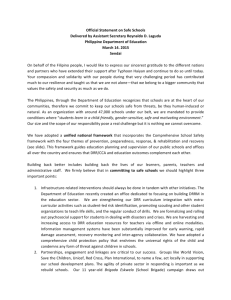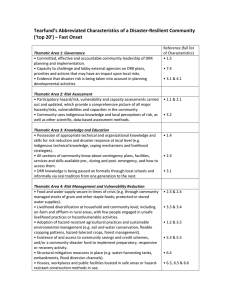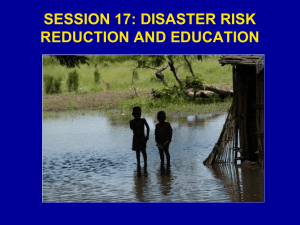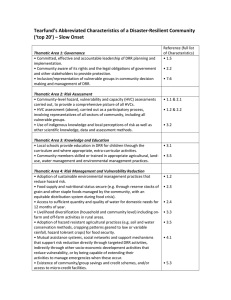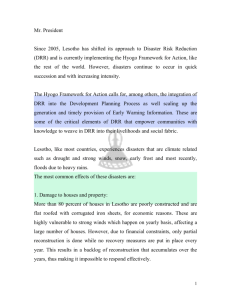4/12/2011 Structure Can Indonesia Incrementally Reduce its Disaster Risks?
advertisement
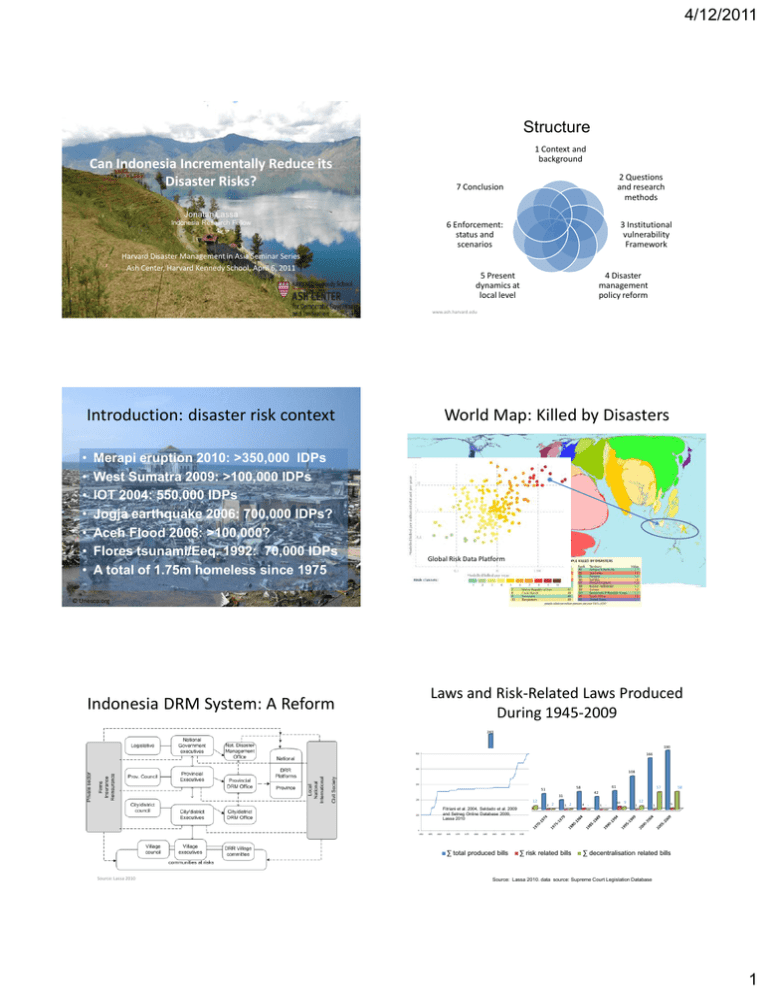
4/12/2011 Structure Can Indonesia Incrementally Reduce its Disaster Risks? 1 Context and background 2 Questions and research methods 7 Conclusion Jonatan Lassa Indonesia Research Fellow 6 Enforcement: status and scenarios Harvard Disaster Management in Asia Seminar Series Ash Center, Harvard Kennedy School, April 6, 2011 3 Institutional vulnerability Framework 5 Present dynamics at local level 4 Disaster management policy reform www.ash.harvard.edu Introduction: disaster risk context • • • • • • • Merapi eruption 2010: >350,000 IDPs West Sumatra 2009: >100,000 IDPs IOT 2004: 550,000 IDPs Jogja earthquake 2006: 700,000 IDPs? Aceh Flood 2006: >100,000? Flores tsunami/Eeq. 1992: 70,000 IDPs A total of 1.75m homeless since 1975 World Map: Killed by Disasters Global Risk Data Platform http://www.worldmapper.org © Copyright 2006 SASI Group and Mark Newman © Unesco.org Indonesia DRM System: A Reform Laws and Risk-Related Laws Produced During 1945-2009 243 190 169 166 100 97 108 91 ∑ total produced bills Source: Lassa 2010 6 12 2 2 58 57 42 31 26 7 3 6 1 5 3 Fitriani et al. 2004, Seldado et al. 2009 and Setneg Online Database 2009, Lassa 2010 4 61 58 51 1 2 ∑ risk related bills 4 - 1 - 10 9 12 1 1 5 ∑ decentralisation related bills Source: Lassa 2010. data source: Supreme Court Legislation Database 1 4/12/2011 Missing links in vertical governance Volatility in governance: how can DRR be independent from it? 70% 60% 50% 40% 30% GR 38 2007 20% 10% 0% 1996 1998 2000 2002 2003 2004 2005 2006 2007 2008 -10% Voice and accountability Regulatory quality Corruption control Linear (Regulatory quality) Government Effectiveness Rule of Law Linear (Voice and accountability) Linear (Rule of Law) Adapted from Kaufmann, Kraay, and Mastruzzi 2009 Source: Lassa 2010, Adapted from Sudarmo and Sudjana 2009 Research questions 1. Can Indonesia incrementally reduce disaster risks? 2. Given the missing links in the vertical governance in Indonesia and the volatility of governance – what kind of enforcement scenarios for disaster risk management policy? 3. What can network theory offer in explaining the vision of risk reduction and the future of Indonesia disaster risk management www.ash.harvard.edu Simple statistical analysis 40 Face to face 52 38 38 www.appleusers.org 32 30 24 20 20 22 22 21 11 10 6 0 1995 Indonesian DRR network 2006-2009 (N=87) Unstructured interviews 58 50 • Risk reduction as multi-level and polycentric governance efforts: Hyogo Framework for Actions • Institutional vulnerability concepts • Disaster risk governance concept • New networked governance and networked institutionalism www.ash.harvard.edu Research methods 60 Conceptual Frameworks 1997 1999 2001 2003 Networks Analysis 2005 2007 Face to face Facebook: wall and messangers Unstructured telpon interviews Mailing lists: facilitated discussions, unfacilitated discussion Skype Formal documents from 45 districts/provinces National level Government 6% 7% International Institutions 17% 1 National Disaster management agency (old) 2 National agency and ministries 45% 3 Other national level 25% organization 4 Media organizati ons NGOs/INGOs 5 Academic/ research institutes Private funds/people 6 National/local NGOs 7 International organizations 8 United Nations agenciesInst. Mixed government-Int. 2 4/12/2011 National level Spending/Allocation National level Spending/Allocation 100% 80% 90% 80% 60% 70% 60% 50% 40% Hyogo Priority V 40% Hyogo Priority IV 30% Hyogo Priority III 20% 20% Hyogo Priority II 10% Hyogo Priority I 0% 0% Actual 2007 Actual 2008 Hyogo Priority I Actual 2009 Plan 2010 Hyogo Priority II Plan 2011 Hyogo Priority III Plan 2012 Total Actual Total Plan 2007-2009 2010-2012 Hyogo Priority IV Hyogo Priority V Actual 2007 Actual 2008 Actual 2009 Hyogo Priority I Plan 2010 Plan 2011 Plan 2012 Hyogo Priority II www.ash.harvard.edu Total Total Plan Actual 2010-2012 2007-2009 Hyogo Priority III Hyogo Priority IV Hyogo Priority V www.ash.harvard.edu HFA 4 Planned activities in IDR Billions Other data on Spending: MoF PNPM in Urban (WB loan) Flood defense (tens of … WB loan road project (WINRIP) 12000 Emergency Dredging … Other infrastructure and … Building codes policy … 10000 DRR sensitive Spatial… Env. Management and vul. … Structural mitigation 8000 Risk Identification … - 5,000 10,000 15,000 6000 Plan 2010 4000 Plan 2011 Plan 2012 120% 100% 2000 20% Hyogo Priority V 80% 68% 0 60% 2004 2005 2006 2007 2008 2009 2010 2011 63% Hyogo Priority IV 79% 88% 81% 40% Hyogo Priority III 63% 71% 64% Hyogo Priority II Hyogo Priority I National disaster management budgeted Other budgeted DRM related Actual Aceh Reconstruction and Rehabilitation (BRR)* National Disaster Management Office* www.ash.harvard.edu 15 Evidence of DRR enforcement mechanism 20% 5% 0% Actual 2007 Actual 2008 Actual 2009 Plan 2010 Plan 2011 Plan 2012 Total 20072009 Total Plan 2010-2012 Source: National Action Plan 2007-2009; 2010-2012; Evaluation Report NAP 2007_2009 Time asymmetry for enforcing DRR regulations (average months) City-district regulation on buildings Name of Law Spatial Planning Law 26/2007 Disaster Management Law 24/2006 Building Law 28/2002 Level of Vertical Enforcement City/Distric Province t Ministerial regulation on buildings Horizontal Enforcement at National Level 6* 11* 18% 2% 30** 250** 90% 50% Enforced e.g. by GR 26/2008 - 10 Mar 2008 on Implementation of Spatial Planning Law, followed by Ministry of Public Works Regulations in 2007 Enforced by GR 21-23/2008 - all signed on 28 Feb 2008, Presidential Decree 08/2008 on National Disaster Management Office N.A.* N.A* Enforced by GR 36/2005 Central government regulation on buildings Substantive Guidelines on Spatial planning at local level (PW Ministry) Central government regulation on Spatial planning implementation Village level DRR implementation Real DRR implementation at city/district City-district regulation on DRR Provincial regulations on DRR Ministerial Guidelines for local govt Government regulation on DRR implementation 0 20 40 60 80 100 120 3 4/12/2011 Hyogo Framework Implementation in Indonesia Network theory: DRR institutions Institutional frameworks and practices Exchange relevant information during hazard events/disasters, Financial reserves and contingency mechanisms are in place 4.0 Financial resources Community participation and decentralization 3.5 3.0 DP plan and contingency plans are in place, regular training drills and rehearsals are held Multi sectoral platform for DRR 2.5 2.0 Strong policy, technical ^ institutional capacities/mechanisms for DRR National and local DRA based on hazard & vulnerability information 1.5 1.0 SOP to assess the risk impacts of major development projects/ infrastructure Monitor, archive and disseminate data on key hazards and vulnerabilities 0.5 0.0 Early warning systems are in place for all major hazards, with outreach to communities DRR are integrated into post disaster-RR Planning and management with DRR elements incl. enforcement of building codes National and local risk assessments take account of regional / trans boundary risks Relevant information on disasters is available and accessible at all levels/stakeholders School curricula, education material and relevant trainings Countrywide public awareness include DRR/RR towards culture of disaster Indonesia 2009 resilience Economic development, Local perception on sectoral dev. And vulnerability reduction constraints Sosial development and vulnerability reduction DRR integration with Environment and NRM & CCA • DRR laws and regulations as nodes • Established links between laws/regulations as either reference, enforcement, vision of risks reduction and operational framework for legal enforcement. • Formal institutions as set of networked laws/regulations spanning from national to locals and vise versa. Indonesia 2011 www.ash.harvard.edu 20 Micro level evidence: HFA Priority 4 1 Ministerial 2 Other local 3 Strategic regulation on DRR regulation s 4 Internati 5 District-city documents onal regulatio ns 6 Provincial DRR regulation 7 Other DRR regulation Ministerial regulations 8 Govt. regulationpresident level 9 Other 10 Disaster managem national ent law laws 24/2007 www.ash.harvard.edu High effectiveness, high institutional resilience High effectiveness, low institutional resilience 1 Central government DRR implementation 2009 Central government DRR implementation 2011 0.9 Effectiveness of implementation 0.8 Central government regulation on DRR Central government regulation on Spatial planning City-district regulation Ministerial on DRR regulation on DRR Ministerial regulation 0.7 City-district regulation on buildings 0.6 on buildings Ministerial regulation on Spatial planning Provincial regulations on DRR City-district regulation on spatial planning 0.5 0.4 City-district level spatial planning implementation City-district regulation on DRR 0.3 0.2 City-district level DRR implementation 0.1 Conclusion • Institutional challenges: complexity, decentralization, governance volatility, regulatory quality, implementation gaps, poor vision of risks. • Decentralization: (dis)incentives for DRR • HFA demands broader and bolder actions • Network theory: new understanding of explaning complexity in disaster legislation and regulations. • New concept of networked institutionalism 0 0 0.1 0.2 Low effectiveness, low institutional resilience 0.3 0.4 0.5 0.6 0.7 Institutional resilience and capacity 23 0.8 0.9 1 Low effectiveness, high institutional resilience 4
